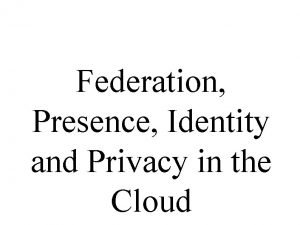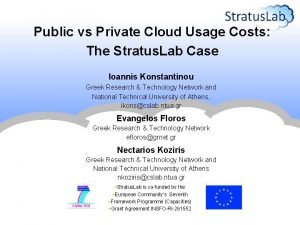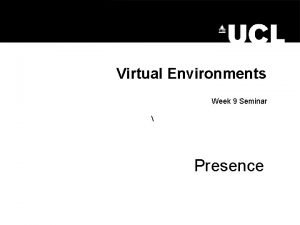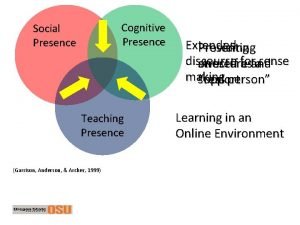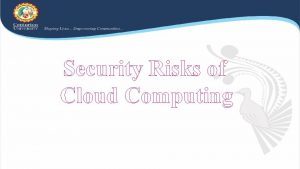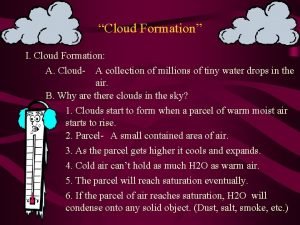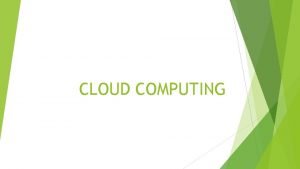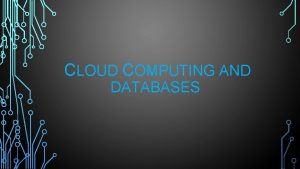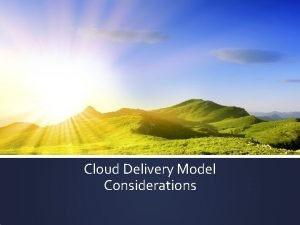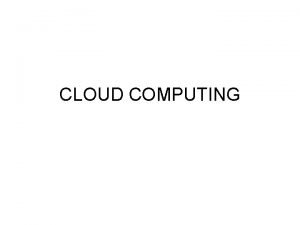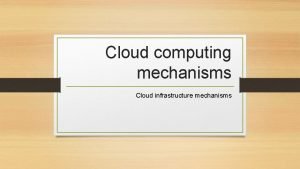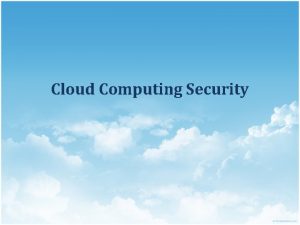Presence in the cloud Understanding presence It provides



















- Slides: 19

Presence in the cloud ØUnderstanding presence It provides true-or-false answers to queries about the network availability of a person, device, or application. ØPresence is a core component of an entity’s real-time identity. Ø Used to determine availability for phones, conference rooms, applications, web-based services, routers, firewalls, servers, appliances, buildings, devices, and other applications.

Presence in the cloud Ø It is an enabling technology for peer-to-peer interaction emerged as an aspect of communication systems, especially IM systems. Ø Protocols used are – Instant Messaging and Presence Service (IMPS), – Session Initiation Protocol (SIP) for Instant Messaging and Presence Leveraging Extensions (SIMPLE) – the Extensible Messaging and Presence Protocol(XMPP) Ø Implementation of presence follows the software design pattern publish-and-subscribe (pub-sub).

Presence Protocols Ø Standard presence protocols, SIMPLE or XMPP which are based on SIP and managed by the Internet Engineering Task Force (IETF) Ø Reliable method to determine another entity’s capabilities is called service discovery –exchanging the information about their capabilities directly, without human involvement. Ø Service discovery and capabilities broadcasts enable users and applications to gain knowledge about the capabilities of other entities on the network, providing a real-time mechanism for additional use of presence-enabled systems.

Leveraging Presence Ø This requires having the ability to publish presence information from a wide range of data sources. Ø The requirements for functioning as a presence publisher are fairly minimal Ø Enabling devices and applications to publish presence information is only half of the solution, however; delivering the right presence information to the right subscribers at the right time is just as important.

Presence Enabled Ø “presence-enabled”? - To show availability of an entity in an appropriate venue. Ø The presence engine acts as a broker for presence publishers and subscribers. Ø The qualities of aggregation, abstraction, and distribution imply that the ideal presence broker is trustworthy, open, and intelligent. Ø Aggregating information from a wide variety of sources requires presence rules that enable subscribers to get the right information at the right time.

Federated Identity Management Ø Network identity is a set of attributes which describes an individual in the digital space. Ø Federated identity management (Id. M) refers to standards-based approaches for handling authentication, single sign-on (SSO), role-based access control, and session management across diverse organizations, security domains, and application platforms. Ø Single sign-on enables a user to log in once and gain access to the resources of multiple software systems without being prompted to log in again

Cloud and Saa. S Identity Management Ø Large enterprise IT shop has implementations for standard identity management functionalities such as user authentication, single sign-on, user management, provisioning/deprovisioning, and audit. Ø Because these implementations were designed and deployed to support users accessing applications running inside the enterprise, they often do not transition well to a model that calls for users to access applications (such as Salesforce. com and Google. Apps) which are hosted outside the corporate firewall.

Cloud and Saa. S Identity Management Ø In June 2008, Salesforce. com disclosed that it was using Security Assertion Markup Language (SAML), an open identity federation standard from OASIS, to implement SSO Ø The key principle behind SAML is an assertion, a statement made by a trusted party about another Ø Assertions can be encoded in browser requests or included in web services transactions, enabling logins for both person-to-machine and machine-to machine communications

Privacy and Its Relation to Cloud-Based Information Systems

Privacy and Its Relation to Cloud-Based Information Systems Ø Information privacy or data privacy is the relationship between collection and dissemination of data, technology, the public expectation of privacy, and the legal issues surrounding them. Ø The challenge in data privacy is to share data while protecting personally identifiable information. Ø Personally identifiable information (PII), as used in information security, refers to information that can be used to uniquely identify, contact, or locate a single person or can be used with other sources to uniquely identify a single individual.

Privacy and Its Relation to Cloud-Based Information Systems Ø Adhering to privacy best practices is simply good business but is typically ensured by legal requirements. Ø Many countries have enacted laws to protect individuals’ right to have their privacy respected, such as – Canada’s Personal Information Protection and Electronic Documents Act (PIPEDA) – the European Commission’s directive on data privacy, the Swiss Federal Data Protection Act (DPA), and the Swiss Federal Data Protection Ordinance. – United States Health Insurance Portability and Accountability Act (HIPAA) – The Gramm-Leach- Bliley Act (GLBA), and – the FCC Customer Proprietary Network Information (CPNI) rules.

Privacy and Its Relation to Cloud-Based Information Systems Ø User data is information collected from a customer, including: – Any data that is collected directly from a customer (e. g. , entered bythe customer via an application’s user interface) – Any data about a customer that is gathered indirectly (e. g. , metadata in documents) – Any data about a customer’s usage behavior (e. g. , logs or history) – Any data relating to a customer’s system (e. g. , system configuration, IP address)

Ø Not all customer/user data collected by a company is personal data. Examples of personal data include: – Contact information (name, email address, phone, postal address) – Forms of identification (Social Security number, driver’s license, passport, fingerprints) – Demographic information (age, gender, ethnicity, religious affiliation, criminal record) – Occupational information (job title, company name, industry) – Health care information (plans, providers, history, insurance, genetic information) – Financial information (bank and credit/debit card account numbers, purchase history, credit records) – Online activity (IP address, cookies, flash cookies, log -in credentials)

Ø A subset of personal data is defined as sensitive and requires a greater level of controlled collection, use, disclosure, and protection. Ø Sensitive data includes some forms of identification such as Social Security number, some demographic information, and information that can be used to gain access to financial accounts, such as credit or debit card numbers and account numbers in combination with any required security code, access code, or password.

Privacy Risks and the Cloud Ø Any information stored locally on a computer can be stored in a cloud, including email, videos, health records, photographs, tax or other financial information, address books, and more. Ø A user’s privacy and confidentiality risks vary significantly with the terms of service and privacy policy established by the cloud provider.

Privacy Risks and the Cloud Ø Information in the cloud may have more than one legal location at the same time, with differing legal consequences. Laws could oblige a cloud provider to examine user records for evidence of criminal activity and other matters. Ø Legal uncertainties make it difficult to assess the status of information in the cloud as well as the privacy and confidentiality protections available to users.

Protecting Privacy Information Ø In general, the basics for protecting data privacy are as follows, whether in a virtualized environment, the cloud, or on a static machine: – Collection: You should have a valid business purpose for developing applications and implementing systems that collect, use or transmit personal data. – Notice: There should be a clear statement to the data owner of a company’s/providers intended collection, use, retention, disclosure, transfer, and protection of personal data. – Choice and consent: The data owner must provide clear and unambiguous consent to the collection, use, retention, disclosure, and protection of personal data.

Protecting Privacy Information – Use: Once it is collected, personal data must only be used (including transfers to third parties) in accordance with the valid business purpose and as stated in the Notice. – Security: Appropriate security measures must be in place (e. g. , encryption) to ensure the confidentiality, integrity, and authentication of personal data during transfer, storage, and use. – Access: Personal data must be available to the owner for review and update. Access to personal data must be restricted to relevant and authorized personnel. – Retention: A process must be in place to ensure that personal data is only retained for the period necessary to accomplish the intended business purpose or that which is required by law.

Protecting Privacy Information – Disposal: The personal data must be disposed of in a secure and appropriate manner (i. e. , using encryption disk erasure or paper shredders). Ø Particular attention to the privacy of personal information should be taken in an a Saa. S and managed services environment when (1) transferring personally identifiable information to and from a customer’s system (2) storing personal information on the customer’s system (3) transferring anonymous data from the customer’s system (4) installing software on a customer’s system (5) storing and processing user data at the company, and (6) deploying servers.
 Presence in cloud computing
Presence in cloud computing Public cloud vs private cloud cost analysis
Public cloud vs private cloud cost analysis Snap cloud
Snap cloud A composable component must be modular
A composable component must be modular Cloud to cloud integration patterns
Cloud to cloud integration patterns Lời thề hippocrates
Lời thề hippocrates Chụp tư thế worms-breton
Chụp tư thế worms-breton đại từ thay thế
đại từ thay thế Vẽ hình chiếu đứng bằng cạnh của vật thể
Vẽ hình chiếu đứng bằng cạnh của vật thể Quá trình desamine hóa có thể tạo ra
Quá trình desamine hóa có thể tạo ra Công thức tiính động năng
Công thức tiính động năng Thế nào là mạng điện lắp đặt kiểu nổi
Thế nào là mạng điện lắp đặt kiểu nổi Khi nào hổ mẹ dạy hổ con săn mồi
Khi nào hổ mẹ dạy hổ con săn mồi Các châu lục và đại dương trên thế giới
Các châu lục và đại dương trên thế giới Dot
Dot Biện pháp chống mỏi cơ
Biện pháp chống mỏi cơ Bổ thể
Bổ thể độ dài liên kết
độ dài liên kết Thiếu nhi thế giới liên hoan
Thiếu nhi thế giới liên hoan Chúa sống lại
Chúa sống lại
